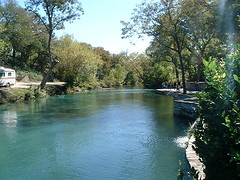Tuesday, April 17, 2007
New Braunfels, TX - Comal River
If you love being in fresh water and have nothing to do on a hot summer day - GO FLOATING!!!
Remember, you are only allowed to bring a 18 qt ice chest and one tube per person!!!
See you on the river!!
Tuesday, April 10, 2007
Bourbon Street, New Orleans
Friday, April 6, 2007
Software Evaluation
Software Evaluation #2
Title of Software: Rosetta Stone
Producer: Fairfield Language Technologies
Target students (e.g., age or grade-level of students): 1st – 12th
Proficiency level (e.g., beginning, intermediate, advanced): All Levels
Description:
This program is designed to teach a new language quickly by using the following type of activities:
*Word/picture identification – the learner must match the correct word with the correct picture. A yellow (a) indicates the response is correct and a red (r) indicates the response is incorrect and other opportunities to respond correctly are provided.
*Listening comprehension – various forms of real-life situations are provided for the learner to listen and respond by matching the correct picture with the words.
*Writing – the learner is able to listen to words, phrases and sentences (as many times as necessary) while using the keyboard to input the correct word syntax.
*Speaking – the learner is able to hear phrases and repeat what was said while a microphone records their voice.
*Reading – one of the final activities for each level is reading. This activity allows for the learner to read the text and provide comprehensible understanding by answering questions that relate to what was just read.
All of the activities are provided in the chosen targeted language and can be used as a reinforcement of particular language skills (prepositions, nouns, etc.) and each lesson begins at a basic level and increases as the learner progresses through each level.
Language skills targeted: Listening, Speaking, Reading and, Writing
Evaluation:
Overall, the program is instructionally appropriate for any level of second language acquisition. The student will be able to navigate easily through each level and an assessment is provided for teacher evaluations. The pictures are “real-world” and most students will be familiar with the photos. Some of the situational practices could be unfamiliar but with practice the students will be able to understand the vocabulary – because of the photos.
Tuesday, April 3, 2007
Reading Prompt #10
Flickr provides students with visuals and "real-world" applications to the world outside the classroom. Many of my ELL's are limited on different experiences that are not provided in the classroom, textbooks or even picture books and the Internet can provide learners with cultural awareness and understanding of our diverse country.
Tuesday, March 27, 2007
Reading Prompt #9
- Time - Since we are responsible for 3 TAKS tests (as I have mentioned before), realistically we are very limited on time with technology lessons, projects and lesson extensions.
- Large classes - I currently have 26 students in my class and with only 4 computers (and no access to the computer lab because of the Reading First Grant) we do a lot of "buddying-up" which is a positive learning experience for ELL's.
- I also have plenty of books on tape in various
 genres and language.
genres and language.
Limitations with technology will continue to exist in any classroom so, it's up to the individual teacher to prepare for her students needs and ensure that technology is integrated in order to create life-long learners.
Tuesday, March 20, 2007
Quick Share
The International Children's Digitial Library (ICDL) provides different types of literature available online for anyone to enjoy in almost any language. http://www.childrenslibrary.org/
Background & History
The ICDL was initially created by an interdisciplinary research team at the University of Maryland in cooperation with the Internet Archive. Members of the team include computer scientists, librarians, educational technologists, classroom teachers, graphic designers, and graduate students from the University of Maryland's (UMD) College of Information Studies (CLIS) and the UMD Human-Computer Interaction Lab (HCIL), a leader in children's interface design.

Other important contributors to the research are the members of the College Park Kidsteam, a group of six children, ages 7-11, who work regularly with the adults in the Lab. The approach used is called cooperative inquiry, a unique partnership between children and adults to develop and evaluate computer interface technologies that support searching, browsing, reading, and sharing books in electronic form. http://www.childrenslibrary.org/about/background.shtml
Reading Prompt #8


